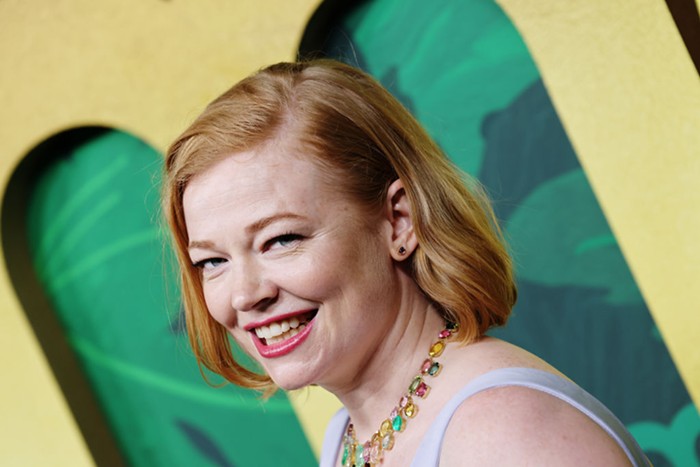
- Courtesy PICA/Ian Douglas
- Dana Michel
The final of image of Dana Michel’s Yellow Towel has been playing on my mind since Saturday night's TBA performance. Before the final lights went down, the audience was drawn to Michel, crouched in the front corner of the stage, a long tan weave-like fabric attached to her head with the other end connected to a whirling blow dryer. In her other hand, Michel held a piece of cardboard, painted black, placed behind her head as if to block the audience’s gaze from what she is doing. And then blackout. No button. No clear-cut ending. No sense of finality.
I was able to speak to Michel briefly after last night’s showing of Yellow Towel and asked her to talk about this last moment. She explained that the fabric was actually a common method that black women use to dry their hair so that it becomes softer (the title Yellow Towel is taken from Michel’s childhood when she would wear one on her head to “emulate blonde girls”). When I asked about the cardboard, if that was part of the hair drying method, she said no. "That was just a piece of black cardboard,” she explained.
I think this last image, and Michel’s explanation of it, has stuck with me because it seems to be representative of what the artist was ultimately getting at with the performance. My take away: Yellow Towel is a play about the shame inducing anxiety brought on by the contemporary and historical expectations hoisted on black women.
This is what I specifically found in the piece. But talking with other audience members after the performance, it was clear there were many other ideas Yellow Towel generated. One audience member commented that he thought the piece was a memory of a day on an urban street corner. Another told me that people have seen Trayvon Martin in the piece. Another thought that it was an attempt to represent the memories of certain family members. Clearly, there was a lot going on in the performance, with many different aspects to think on and wonder about.
A commonality amongst audience members were feelings of frustration and discomfort as the piece progressed. The piece lacked a starting note. With the house lights still on, Michel entered unceremoniously, dressed all in black—black hoodie, black pants—and proceeded to speak inaudibly, moving across the stage embodying (both accurately and poetically) what I assumed to be a homeless addict. Michel would begin an uncomfortable ritual of sorts, spreading a white substance across her face. She lounged on a white cushion (the set was essentially all made up by white pieces), sloppily drinking milk and pouring it down her chin. All the while, Michel sputtered words and unfinished sentences. Twenty minutes into the piece, the house lights were still on (they remained so), the space was still silent aside from Michel’s mumblings, and it was clear that viewers were getting restless.
The piece progressed from there as Michel shifted and changed costumes, becoming at one point what I thought to be herself from childhood, eating and spitting out food items such as bananas and white crackers. Then perhaps progressing further on into life (a teenager maybe?), Michel played out a phone conversation with an aunt or grandmother who was teaching her how to make a baked crisp. Then, Michel revealed a blonde wig that she attempted to brush with an afro-pick before attaching it to her own hair.
Music was eventually incorporated in the performance as well as a couple light cues, but these seemed out of place compared to the overall starkness of the piece so far. My audience companion noted after the show that he was puzzled by the sound choices. "It was all so much, but also not enough," he said.
This might be a fitting critique of Yellow Towel on a whole. For some audience members, the show was “so much”—perhaps too much. I noted five walk-outs during the piece. I can’t recall the last time I saw audience members walk out on a performance in Portland. And yet in the end, Michel received a standing ovation from many of the remaining audience members. The show was meant to be challenging, to show you too much, to get under and into your skin, so that you might have a reaction. Some would say that this is the exact point of performance art.
But was the piece also not enough? I found that I wanted more communication between performer and audience—something to help us steer our way towards the artist’s statement. That said, I naturally look for sign posts and narrative when watching any kind of performance, and I don’t know if this is what Dana Michel was getting at with the feelings of confusion prompted by her piece. I left believing that Michel was after that reaction in Yellow Towel. The question that still remains for me, however, is if that intentionality is something that most audience members picked up on.
Further reading:
• With Beyoncé and Blue Paint, Ten Tiny Dances' Triumphant Return to TBA
• Reckoning with Tyondai Braxton's Restless Synths
• Confronting the Audience in Keyon Gaskin's Its Not a Thing at BodyVox
• Pictures of the Moon with Teeth: TBA's Visual Art Tackles Spirits and Space
• B-Boys Deconstruct Gender in Amy O'Neal's Opposing Forces
• Dynasty Handbag's Delusions and Grandeur












